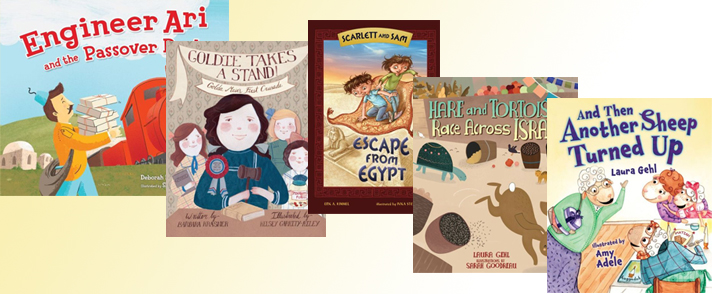By Rita Berman Frischer, Special to The Jewish Sound
The Hebrew people may have schlepped on foot for 40 years, but modern transportation has updated traveling to and through the Promised Land. Kar-Ben Publishing marks this year’s Festival of Freedom, Passover, by featuring “Engineer Ari” and his intrepid train as a perfect vehicle for explaining the seder and its symbols. “Engineer Ari and the Passover Rush” by Deborah Bodin Cohen, illustrated by Israeli artist Shahar Kober, is the fourth in this series, which has also spotlighted Rosh Hashanah, Sukkot and Hanukkah.
Just one day before the seder, Engineer Ari must travel to Jerusalem and back to Jaffa to buy and collect all the things he needs for his seder. Fortunately, he has many good friends and neighbors who share various items with him. Still, while in Jerusalem, he must visit the matzoh factory to get the matzoh for everyone else’s seders, a big responsibility. Rushing, he makes it back home, exhausted, just in time for the holiday seder to begin. The story effectively includes an introduction to all the things associated with the holiday’s observance, including a description of how matzoh is made. As Ari’s train chugs through a landscape circa 1893, the illustrator indirectly provides a visual history lesson as well as considerable charm.
Back matter includes a brief background about Passover and an actual photograph of the first train between Jaffa and Jerusalem, shortening the trip from three days to three-and-a-half hours. Eliezer Ban-Yehuda, father of modern Hebrew, named the early trains “rakevet” from the Biblical word for “chariot.”
“And Then Another Sheep Turned Up” by Laura Gehl, illustrated by English artist Amy Adele, is a story in rhyme with minimum words and with maximum artistic exuberance. The Sheep family — Mama, Papa, Hannah and Noah—have worked hard and believe they are all ready for their seder. But life is full of surprises and just as they are about to begin, to the family’s delight another sheep, Grandma, hurries in. But no sooner have they added another chair and all been seated then, guess what? Here comes Uncle Sol. And Grandpa…and later yet, Danny. And…Sharon…and Aunt Deb. My question: Where’s Elijah? Is there room for him?
This story includes all the most important elements of the seder and gives an ample opportunity for an elementary exercise in addition. It seems to me parents might also want to use it as a springboard for talking about the positive value of hospitality and, on the other hand, the importance of showing consideration by actually letting people know ahead that you’ll be coming over expecting to be fed.
Portland author Eric Kimmel has been writing for children for over 40 years and has built his career largely on books for younger children. This year, however, he joined the time-travel brigade, with “Scarlett and Sam Escape From Egypt,” a Kar-Ben chapter book for ages 6 to 9, illustrated in black and white by Ivica Stevanovic. For 17 chapters, he takes squabbling twins Scarlett and Sam back to the Egypt of the Exodus, courtesy of their grandmother’s time-traveling carpet. The twins have heard about the Exodus during many seders, but when they find themselves drawn into the story as participants, along with Moses, Aaron and Miriam, things look quite different, especially after they’ve made friends with the Pharaoh’s oldest son.
I’m a devoted fan of most of Kimmel’s works for younger children, but I have to confess that the time travel approach to Biblical stories doesn’t usually work for me. First-hand reports on each of the plagues? Modern quips by modern kids in Goshen? But then, I’m not a 7- or 8-year-old. Kimmel’s usual careful workmanship should hold his young readers and they will probably learn a lot from this accessible, quick moving, and exciting approach to the Passover story.
This month we also celebrate Yom Ha’Atzmaut, Israel’s Independence Day, so I will conclude this column — and my several years of pleasurable connection with this paper — with two works about Israel. The first, “Goldie Takes a Stand: Golda Meir’s First Crusade,” written by Barbara Krasner and illustrated by Kelsey Garrity-Riley, introduces the young Goldie, living in America, as she becomes an activist at age 9, raising money to buy school books for other immigrant children. Readers 5 to 9 will see the simple way Goldie’s concern turned into positive action. Back matter shows pictures of Golda Meir at age 6 and as prime minister of Israel and gives a brief bio, references, and a bibliography.
“Hare and Tortoise Race Across Israel,” another book by Laura Gehl, features not a family of sheep but a pair of classic opponents, Hare and Tortoise, who live together in Tel Aviv as friends. One day, watching the trains come and go (see the connection with Engineer Ari?), they decide to race each other, this time across the Promised Land all the way to the Dead Sea. En route, illustrator Sarah Goodreau exposes them and us to the rich daily activities of Israeli life, very distracting, especially to over-confident Hare. Young readers will enjoy the trip and be glad when the two friends, both exhausted, finally rest their aching muscles by floating in the Dead Sea.
Thank you for letting me share my love of children’s books with you these past years. L’hitraot.
